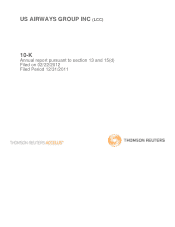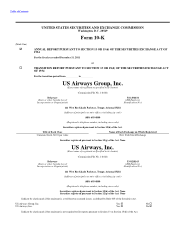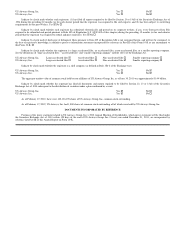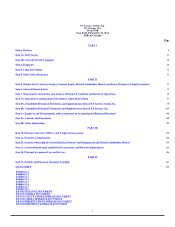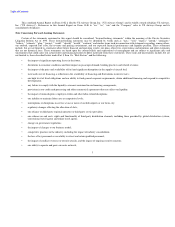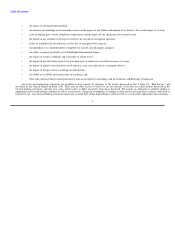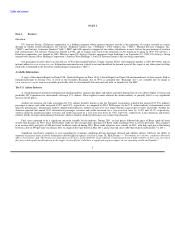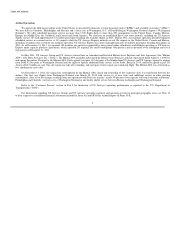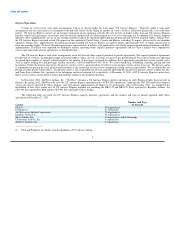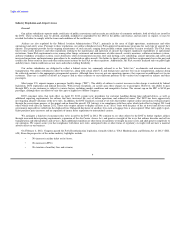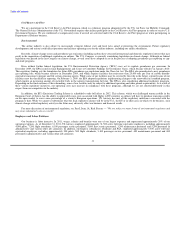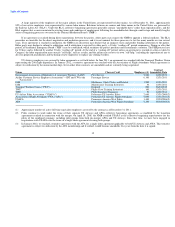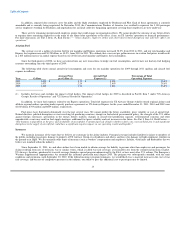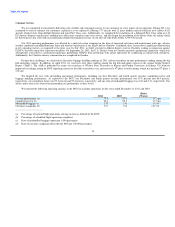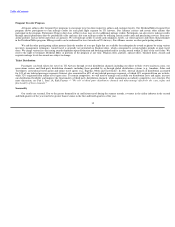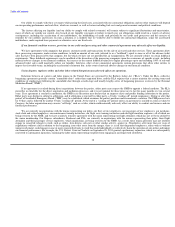US Airways 2011 Annual Report Download - page 11
Download and view the complete annual report
Please find page 11 of the 2011 US Airways annual report below. You can navigate through the pages in the report by either clicking on the pages listed below, or by using the keyword search tool below to find specific information within the annual report.
Table of Contents
Marketing and Alliance Agreements with Other Airlines
We maintain alliance agreements with several leading domestic and international carriers to give customers a greater choice of destinations. Airline
alliance agreements provide an array of benefits that vary by partner. By code sharing, each airline is able to offer additional destinations to its customers
under its flight designator code without materially increasing operating expenses and capital expenditures. Through frequent flyer arrangements, members are
provided with extended networks for earning and redeeming miles on partner carriers. US Airways Club members also have access to certain partner carriers'
airport lounges. We also benefit from the distribution strengths of each of our partner carriers.
US Airways is a member of the Star Alliance, the world's largest airline alliance, which now has 27 member airlines serving approximately 1,290
destinations in 189 countries. Membership in the Star Alliance further enhances the value of our domestic and international route network by allowing
customers wide access to the global marketplace. Expanded benefits for customers include network expansion, frequent flyer program benefits, airport lounge
access, convenient single-ticket pricing with electronic tickets, one-stop check-in and coordinated baggage handling. We also have bilateral marketing/code
sharing agreements with Star Alliance members Air China, Air New Zealand, ANA, Asiana, bmi, Brussels Airlines, Lufthansa, Singapore Airlines, Swiss
International, TAM, TAP Portugal, Turkish Airlines and United. Other international code sharing partners include EVA Airways, Qatar Airways, Royal
Jordanian Airlines, TACA and Virgin Atlantic Airways. Marketing/code sharing agreements are maintained with two smaller regional carriers in the
Caribbean that operate collectively as the "GoCaribbean" network. Each of these code share agreements funnel international traffic onto our domestic flights
or support specific European and Caribbean markets in which we operate. Domestically, we code share with Hawaiian Airlines on intra-Hawaii flights.
Competition in the Airline Industry
The markets in which we operate are highly competitive. Price competition occurs on a market-by-market basis through price discounts, changes in
pricing structures, fare matching, target promotions and frequent flyer initiatives. Airlines typically use discount fares and other promotions to stimulate traffic
during normally slack travel periods, when they begin service to new cities or when they have excess capacity, to generate cash flow and maximize revenue
per ASM and to establish, increase or preserve market share. Discount and promotional fares are generally non-refundable and may be subject to various
restrictions such as minimum stay requirements, advance ticketing, limited seating and change fees. We have often elected to match discount or promotional
fares initiated by other air carriers in certain markets in order to compete in those markets. Most airlines will quickly match price reductions in a particular
market. Our ability to compete on the basis of price is limited by our fixed costs and depends on our ability to manage effectively our operating costs. Some of
our competitors have greater financial resources and/or lower cost structures than we do. In addition, recent years have seen the growth of low-fare, low-cost
competitors in many of the markets in which we operate. These competitors include Southwest, JetBlue, Allegiant, Frontier, Virgin America and Spirit. These
low cost carriers generally have lower cost structures than US Airways.
In addition to price competition, airlines compete for market share by increasing the size of their route system and the number of markets they serve.
Airlines with international operations are less exposed to domestic economic conditions and may be able to offset less profitable domestic fares with more
profitable international fares. We also compete on the basis of scheduling (frequency and flight times), availability of nonstop flights, on-time performance,
type of equipment, cabin configuration, amenities provided to passengers, frequent flyer programs, the automation of travel agent reservation systems, on-
board products, markets served and other services. We compete with both major full service airlines and low-cost airlines throughout our network.
Additionally, because we operate a significant number of flights in the eastern United States, our average trip distance, or stage length, is shorter than
those of other major airlines. This makes us more susceptible than other major airlines to competition from surface transportation such as automobiles and
trains. Surface competition can be more significant during economic downturns when consumers cut back on discretionary spending.
8

